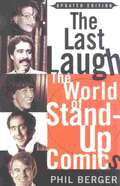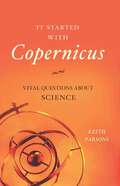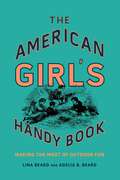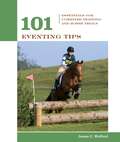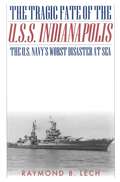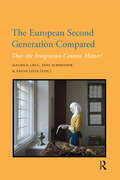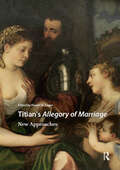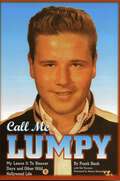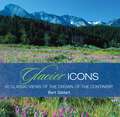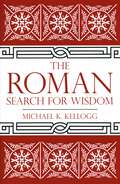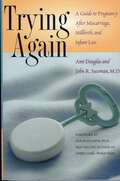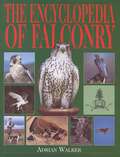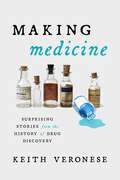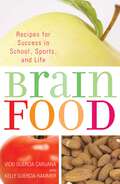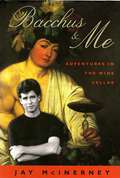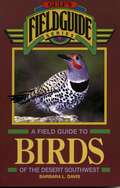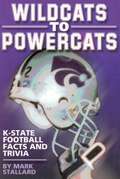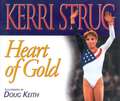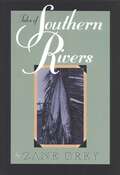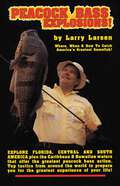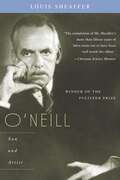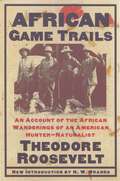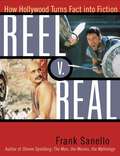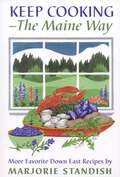- Table View
- List View
The Last Laugh: The World of Stand-Up Comics
by Phil BergerThe Last Laugh is the first and only book to take readers deep into the bizarre universe of the standup comic, from the classic years of Milton Berle, Sid Caesar, and Shecky Greene, to today's comedy superstars. Phil Berger shows how styles and trends in standup have changed over the past fifty years, but how taking the stage in a comedy club is as tough as it's always been. Performers profiled in the book include Woody Allen, Lenny Bruce, George Carlin, Elaine Boosler, Robert Klein, Bill Cosby, Billy Crystal, Dick Gregory, Andy Kaufman, Steve Martin, Cheech and Chong, Eddie Murphy, and a host of others. Filled with comics' hilarious routines and anecdotes, this substantially updated edition also chronicles the lives and careers of more recent artists, including Richard Lewis and Jay Leno.
It Started with Copernicus: Vital Questions about Science
by Keith ParsonsA unique approach to the philosophy of science that focuses on the liveliest and most important controversies surrounding science Is science more rational or objective than any other intellectual endeavor? Are scientific theories accurate depictions of reality or just useful devices for manipulating the environment? These core questions are the focus of this unique approach to the philosophy of science. Unlike standard textbooks, this book does not attempt a comprehensive review of the entire field, but makes a selection of the most vibrant debates and issues. The author tackles such stimulating questions as: Can science meet the challenges of skeptics? Should science address questions traditionally reserved for philosophy and religion? Further, does science leave room for human values, free will, and moral responsibility? Written in an accessible, jargon-free style, the text succinctly presents complex ideas in an easily understandable fashion. By using numerous examples taken from diverse areas such as evolutionary theory, paleontology, and astronomy, the author piques readers' curiosity in current scientific controversies. Concise bibliographic essays at the end of each chapter invite readers to sample ideas different from the ones offered in the text and to explore the range of opinions on each topic. Rigorous yet highly readable, this excellent invitation to the philosophy of science makes a convincing case that understanding the nature of science is essential for understanding life itself.
The American Girl's Handy Book: Making the Most of Outdoor Fun
by Adelia B. Beard Lina BeardEach summer, millions of children complain, "There's nothing to do." Originally published in 1889, The American Girl's Handy Book resoundingly challenges this age-old dilemma by providing a huge number of ideas for fun and instructional projects for young girls. It includes plans for April Fool's parties and jokes, transplanting wildflowers and preserving or pressing them, Easter games and activities, instructions for making a lawn tennis net and the rules of the game, how to make a hammock, corn husk and flower dolls, instructions for making various fans, Halloween parties, making a telephone, painting in water or oil colors, making models in clay and wax, making picture frames, and suggestions for winter games and activities! As with its companion, The American Boy's Handy Book, the girl's book is divided into seasons ensuring fun will be had all year round.
101 Eventing Tips: Essentials For Combined Training And Horse Trials (101 Tips)
by James WoffordThree-day eventing, known as the &“complete competition,&” requires the same horse-and-rider team to ride a dressage test, a demanding cross-country obstacle course, and a show-jumping round. 101 Eventing Tips includes advice on selecting a horse, establishing horse-and-rider training programs and taking part in entry-level competitions.
The Tragic Fate of the U.S.S. Indianapolis: The U.S. Navy's Worst Disaster at Sea
by Raymond B. LechOn July 29, 1945, four days after delivering the atomic bomb destined for Hiroshima, the U.S.S. Indianapolis was torpedoed and sunk. of the 1,199 men on board, 883 perished. Culled from previously unavailable files, this is the chilling story of how the U. S. Navy left the crew in shark-infested waters for four days, and why only a fraction of the 800 men who safely abandoned the ship survived the ordeal. This is the true story of the massive thirty-year cover-up that followed.
The European Second Generation Compared: Does the Integration Context Matter? (IMISCOE Research)
by Maurice Crul Jens Schneider Frans LelieIntegration of newcomers is a foremost challenge for contemporary Europe. The ‘second generation’ – children born of immigrant parentage – is crucial in this process, for they constitute a growing and increasingly vocal segment of the metropolitan youth. This book offers an unprecedented look at the real-life place and position of the European second generation in education, labour, social relations, religion and identity formation. Using data collected by the TIES survey in fifteen cities across eight European countries, the authors paint a vivid picture of how the children of immigrants from Turkey, Morocco and former Yugoslavia are progressing. Their findings and cross-national comparisons are demographically compelling and at times revelational.
Titian's Allegory of Marriage: New Approaches (Visual and Material Culture, 1300-1700)
by Daniel M. UngerThis book offers nine new approaches toward a single work of art, Titian’s Allegory of Marriage or Allegory of Alfonso d’Avalos, dated to 1530/5. In earlier references, the painting was named simply Allegory, alluding to its enigmatic nature. The work follows in a tradition of such ambiguous Venetian paintings as Giovanni Bellini’s Sacred Allegory and Giorgione’s Tempest. Throughout the years, Titian’s Allegory has engendered a range of diverse interpretations. Art historians such as Hans Tietze, Erwin Panofsky, Walter Friedlaender, and Louis Hourticq, to mention only a few, promoted various explanations. This book offers novel approaches and suggests new meanings toward a further understanding of this somewhat abstruse painting..
Call Me Lumpy: My Leave It To Beaver Days and Other Wild Hollywood Life
by Bank BankFrank Bank's story is a sometimes wild, sometimes bawdy, often poignant, always funny account of a real-life Louie Louie who led a nation to California-dreamin'.
Glacier Icons: 50 Classic Views Of The Crown Of The Continent (Icons)
by Jane GildartFrom the mountain goats who linger by the visitor's center on Logan Pass to the crystal-clear glacier-fed lakes, from the magnificent views from the Many Glacier Hotel to the old-growth forest landscapes, visitors will find much to ponder and enjoy within these pages. In 1903 writer, editor, and naturalist George Bird Grinnell expressed his thoughts in Century Magazine about this land he had come to love, calling the area the "Crown of the Continent." His image of and descriptive story about the magnificent glacier-carved landscape in the far reaches of Montana brought about the creation of Glacier National Park in 1910. Grinnell's description is apt, but it is just one of the collective descriptions that evokes iconic images of Glacier, also called the "Land of Shining Mountains" and known by many millions of visitors for their own personal stories and connections to its magnificent vistas and small wonders.Glacier Icons contains fifty chapters filled with thousands of facts and hundreds of full-color photographs of iconic people, places, events, foods, animals, traditions, and more from all parts of this great national park.
Roman Search for Wisdom
by Michael K. KelloggThe Roman "philosophy of life" as mirrored in the literature of ten outstanding representative authors Though Rome conquered much of the world and established an empire that lasted more than a millennium, its citizens sometimes expressed a sense of inferiority to the intellectual accomplishments of ancient Greece. The notion that Roman philosophers, thinkers, and writers were just pale imitations of Greek originals has persisted to this day. Even the great Roman poet Horace wrote, "Captive Greece took its Roman captor captive,/ Invading uncouth Latium with its arts." Michael K. Kellogg puts this notion to rest in this lively, very readable overview of Roman literature. The author uncovers many examples of Roman wisdom, showing that the Roman contribution to intellectual history is considerable and need not take second place to ancient Greek literature. Kellogg offers fresh and engaging portraits of poets (Lucretius, Virgil, Horace, Ovid); dramatists (Plautus, Terence, Seneca); biographers (Plutarch, Suetonius); historians (Livy, Tacitus); and philosophers (Cicero, Marcus Aurelius), against the background of Roman history. The contemporary reader will come away from this excellent survey with the realization that even today our culture still bears the lasting imprint of ancient Rome.
Trying Again: A Guide to Pregnancy After Miscarriage, Stillbirth, and Infant Loss
by John R. Sussman Ann DouglasWritten especially for parents who have lost a child, Trying Again provides facts to help determine whether you, or your partner, are emotionally ready for another pregnancy.
The Encyclopedia of Falconry
by Adrian WalkerThis lavishly illustrated encyclopedia contains some 1,500 terms and idioms, related to or connected with falconry, with explanations, derivations and notes. It is illustrated with photographs, figures, and reproductions of antiquarian prints and is believed to be the first attempt to catalog and review the complete language of falconry as used between the later Middle Ages and the present day.The Encyclopedia of Falconry will be a valuable addition to all reference collections by uniquely covering a subject with a long and distinguished history.
Making Medicine: Surprising Stories from the History of Drug Discovery
by Keith VeroneseHow do scientists design the medicine we use to improve our lives? It turns out that many are happy accidents or overlooked mixtures of carbon and hydrogen that go on to not only improve the lives of people the world over, but become million- and billion-dollar makers for pharmaceutical companies.In Making Medicine: Surprising Stories from the History of Drug Discovery, author Keith Veroneseexamines fifteen different molecules and their unlikely discovery –or in many cases, their second discovery –en route to becoming invaluable medications. From the famous story of Alexander Fleming&’s discovery of penicillin, to lesser-known stories surrounding drugs like quinine (derived from the bark of the cinchona tree and responsible for saving the lives of millions in the fight against malaria), Veronese reveals the &“how&” and the &“who&” behind the pharmaceutical breakthroughs that continue to impact our world. With subjects including cancer-fighting therapies and over-the-counter pain relievers; hair regrowth creams and antidepressants; readers will no doubt have a personal connection to at least one molecule in this book.Like all discoveries made by mankind, the stories behind these breakthroughs and their introduction to the world are often messy, sometimes controversial, and always human. Take digoxin, which correctly prescribed can help heart efficiency, but in higher doses can prove fatal –a fact known all too well by Charles Cullen, a nurse who used digoxin to kill over forty patients. Making Medicine also details how modern pharmaceutical discovery works, including the monumental challenge and accomplishment of creating a COVID-19 vaccine. This fascinating book highlights the serendipitous nature of the discovery of these miracle molecules, along with how they do (or don't) interact with the human body to produce the desired result.
Brain Food: Recipes for Success for School, Sports, and Life
by Vicki Guercia Caruana Kelly Guercia HammerReports abound on the direct connection between how well kids eat and how succesful they are at learning and competing in sports. But what should they eat? A nutrionist and an educator explain what to feed growing kids ages one to eighteen, including those with diabetes, food allergis, and AD/HD, to develop their maximum physical and mental potential. Meals plans and recipes showcase specific "brain stimulating" foods along with practical suggestions for preparing and serving brain foods (including snacks) that kids will actually eat.
The Super Anti-Oxidants: Why They Will Change the Face of Healthcare in the 21st Century
by James F. BalchThis book provides detailed information about various illnesses and how they can be prevented or cured through the use of anti-oxidants.
Bacchus & Me: Adventures in the Wine Cellar
by Jay McInerneyWith acerbic wit, irreverent tone, and bountiful hilarious anecdotes, Jay McInerney writes the first wine book that makes sense to all those dazed by the prevailing, dull technical wine writing. McInerney generously reveals all he's learned on his worldwide journey to understand wine in chapters on reds, whites, dessert wines, champagne, aperitifs, and more. McInerney holds forth in forty-nine essays - with agile humor; an astonishing amount of hard fact, and an ample dose of personal taste - on: how to make your way around a German wine label; what to drink with Thanksgiving turkey; the truth about Zinfandels; why Burgundy is so hard to predict; Napa Valley's finest winemakers; the pleasure of flinty Chablis, the deep satisfaction of port, the glorious potential of Oregon's Pinot Noir; the respectability of RosT; and the most colorful characters in the business. It is actually possible for a reader of Bacchus & Me to take what is learned to the bank, and immediately thereafter to wine shop or restaurant to indulge in the wine of his or her fantasy with the confidence of a sommelier. Bacchus & Me is for everyone interested in learning more about the wines of the world. For both those of broad means and of modest purse, there is intense vicarious pleasure to be found in McInerney's vinous adventures.
A Field Guide to Birds of the Desert Southwest
by Barbara L. DavisThis field guide takes you to the desert and grassland areas of Arizona, California, and New Mexico where the total number of bird species reaches a staggering 440. Included are 21 desert birding hot spots, in-depth descriptions and behavioral information, 8 bird charts, and much more.
Wildcats to Powercats: K-State Football Facts and Trivia
by Mark StallardBeginning with the first official football game played by K-State in 1896, the purple-clad gridders always struggled to find respectability. By the end of the 1980s, the team was mired in a 30-game winless streak and considered the worst college football team in America.Then the turn around.Bill Snyder took over the head coaching duties at K-State in 1989, and within five seasons did something many thought impossible, if not miraculous: he turned Kansas State into not only a winning program, but a dominant contender in the world of college football.From Wildcats to Powercats.Test your trivia knowledge with questions about players, coaches and big games, from George Maddox and Pappy Waldorf to Michael Bishop and Bill Snyder. From Independence Bowl to the Fiesta Bowl. Complete with hundreds of questions, facts and photos.
Heart of Gold
by Kerri StrugIn her first book, Olympic gold medalist Kerri Strug reveals the keys to her success in the demanding and pressure-packed world of elite gymnastics. Strug's insights will provide children with a road map for attaining a heart of gold. Color photos/illustrations.
Tales of Southern Rivers
by Zane GreyWhen not writing his famous Western novels, Zane Grey was an insatiable angler. Tales of Southern Rivers recounts his tales of fishing in the Gulf of Mexico, the Florida Keys, the Everglades, and on remote rivers in the jungles of Mexico. With many of these venues being some of today's most popular saltwater fly-fishing destinations, no one will want to miss these highly entertaining and informative yarns. Armchair fishing will never be the same.
Peacock Bass Explosions
by Larry LarsenExplore Florida, Central and South America plus the Caribbean & Hawaiian waters that offer the greatest peacock bass action. Top tactics from around the world to prepare you for the greatest experience of your life!
O'Neill: Son and Artist
by Louis ScheafferThe most lauded playwright in American history, Eugene O'Neill (1888-1953) won four Pulitzer Prizes and a Nobel Prize for a body of work that includes The Iceman Cometh, Mourning Becomes Electra, Desire Under the Elms, and Long Day's Journey into Night. His life, the direct source for so much of his art, was one of personal tumult from the very beginning. The son of a famous actor and a quiet, morphine-addicted mother, O'Neill had experienced alcoholism, a collapse of his health, and bouts of mania while still a young man. Based on years of extensive research and access to previously untapped sources, Sheaffer's authoritative biography examines how the pain of O'Neill's childhood fed his desire to write dramas and affected his artistically successful and emotionally disastrous life.
African Game Trails: An Account of the African Wanderings of an American Hunter-Natrualist
by Theodore RooseveltIn 1909, the Smithsonian Institution commissioned ex-President Theodore Roosevelt to collect specimens of African wildlife for the National Museum. Roosevelt went to Africa with his son Kermit, several prominent naturalists, and many journalists, thereby initiating the safari industry and setting the standard for the big game hunt. Yet Roosevelt never killed for thrills, instead hunting only specific animals in the amounts requested by the Smithsonian. Making his way from the Kenyan coast to the Upper Nile, he records his impressions of the African landscape, witnesses a traditional lion hunt by African pastoralists, and recalls his meetings with East Africans, to whom he was known as 'Bwana Tumbo (belly).'
Reel V. Real: How Hollywood Turns Fact into Fiction
by Frank SanelloAll too often, highly fictionalized cinematic depictions of the past are accepted as the unassailable truth by those unfamiliar with the "real" account. This book profiles sixty movies that portray actual moments in history, and compares the mythologized account of each event to what really happened. Movies chronicled include The Ten Commandments, Spartacus, A Man for All Seasons, Gladiator, Gandhi, Apollo 13, The Thin Red Line, Dances with Wolves, Braveheart, The Last Emperor, All the Presidents Men, Mutiny on the Bounty, Gone with the Wind, Bonnie & Clyde, Patton, and Elizabeth. Sanello also contrasts several historical figures with their filmed treatments, including Julius Caesar, Henry V, Christopher Columbus, Joan of Arc, Sir Thomas More, Jesus Christ, Catherine the Great, Sigmund Freud, and Harry Houdini. Lavishly illustrated with sixty film stills, Reel v. Real shows how a happening's genuine details are frequently reshaped and distorted by Hollywood's bottomless appetite for over-the-top flamboyance and melodrama.
Keep Cooking--the Maine Way
by Marjorie Standish"Not everyone gets a chance to write a second cookbook," writes Marjorie Standish. "That's the reason I feel so grateful that this book came about." After the phenomenal success of her first book, Cooking Down East, it was inevitable that her readers clamored for a second collection of tried-and-true Maine recipes. Fortunately the longtime Maine Sunday Telegram columnist was glad to oblige, and another bestseller, Keep Cooking--the Maine way, was the result.Readers of Mrs. Standish's newspaper column shared their favorite recipes generously, which gives this cookbook a pleasing variety and unpretentiousness. "Maine cooking is a way of life. It is evident as you use these recipes," the author writes in her Foreword. "You will find all kinds: they came from our family and they from yours. If you felt proud enough of your family recipes to share them in my column, then they have deep meaning for all of us. . . . It is like opening a treasure chest to share a recipe."
